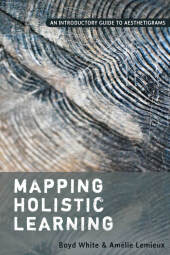 Neuerscheinungen 2017Stand: 2020-02-01 |
Schnellsuche
ISBN/Stichwort/Autor
|
Herderstraße 10
10625 Berlin
Tel.: 030 315 714 16
Fax 030 315 714 14
info@buchspektrum.de |

Amélie Lemieux, Boyd White
(Beteiligte)
Mapping Holistic Learning
An Introductory Guide to Aesthetigrams
Neuausg. 2017. XVIII, 146 S. 225 mm
Verlag/Jahr: PETER LANG LTD. INTERNATIONAL ACADEMIC PUBLISHERS 2017
ISBN: 1-433-13276-1 (1433132761)
Neue ISBN: 978-1-433-13276-6 (9781433132766)
Preis und Lieferzeit: Bitte klicken
Mapping Holisitic Learning: An Introductory Guide to Aestetigrams introduces the concept of aesthetigrams. These are participant-produced visual maps of aesthetic engagement.
Mapping Holistic Learning: An Introductory Guide to Aesthetigrams introduces the concept of aesthetigrams. These are participant-produced visual maps of aesthetic engagement. The map-making strategy was originally developed by one of the authors, Boyd White, to assist him in understanding what his university-level students were experiencing as they interacted with artworks. Such interactions are, after all, private, individualistic, and fleeting. How can a teacher foster student/teacher dialogue that might lead to enhanced engagement, much less do research, without a concrete record of such engagement? Aesthetigrams provide that record.
Recently, the strategy has been adapted to other fields of study-the teaching of literature, and philosophy for children, as well as the writing of poetry. Boyd White and Amélie Lemieux are persuaded that the strategy could be expanded into other disciplines. For example, might it not be useful for a teacher to know what a student is feeling and thinking as she struggles with a mathematical concept?
Mapping Holistic Learning is divided into three sections. Chapter 1 addresses the theoretical framework that underpins the authors´ research. The second section, Chapters 2 to 5, provides examples of aesthetigram usage within the formal education environment, in art and literature classrooms. The third section, Chapters 6 and 7, introduces two recent experiments in informal settings-one in an adult poetry workshop, the other in a philosophy-for-children workshop. It is not necessary to follow the book in chronological order. Readers are invited to attend to the chapters that most closely address their individual interests.
List of Figures - Acknowledgements - Boyd White and Amélie Lemieux: Introduction - Amélie Lemieux and Boyd White: Epistemological and Ontological Stances - Boyd White: Putting Theory into Practice: Aesthetigrams: Mapping Aesthetic Experiences - Boyd White: More Recent Developments: Visual Art - Amélie Lemieux: Recent Developments: Aesthetigram-Making in the Literature Classroom - Amélie Lemieux: Applications with CEGEP (18-20-Year-Old) Students - Introduction: Other Applications - Boyd White: The Poetry Workshop - Natalie M. Fletcher: Philosograms as Aesthetic Maps of Philosophical Inquiry - Contributor´s Bio - Index
"This book fills a great need that has existed since our world of reading and writing became so multimodal. Boyd White and Amélie Lemieux provide an entrée into the world of aesthetics for any teacher who is interested in adding to their students´ responsive palettes. The technique of using ´aesthetigrams,´ as described by White and Lemieux, will enable teachers and students to share a common vocabulary for articulating what is often difficult to articulate." -William Kist, Professor, Kent State University, Author, New Literacies in Action and Getting Started with Blended Learning


